Well hello blog and I finally succumbed to the inspiration.
Tonight, an (ex)colleague, an esteemed mentor, Brad Merrick introduced me to Ben Folds (yeah, which rock have I been hiding under?). Anyway, it wasn’t just any music video (Ben Folds has lots!); it was this where Ben composes a song in 10 minutes using crowd-sourced inspiration (A minor !!! upbeat – in a minor key?!?, and ‘These new spaces – The Kennedy Center – are all designed to be flexible)!
There are lots of amazing things from this video which you’ve got to watch, if you haven’t yet. I do want to highlight the following in particular:
- Ben and the musicians looked like they were enjoying this process – a palpable sense of playfulness
- The trust! Ben trusted – and respected the skills of – the musicians and vice versa – “You know what you must do”
- Each one brought their own specialty/expertise and what a rich texture of sounds they created…harmoniously (and that’s part of the genius, right?)…”Let’s hear it all together and make sure it’s not crazy”
- Communicating via the conductor. Communicating via the music jargon, e.g. keys, chords, and volume (mezzo forte, forte, …fortissimo…and the five-tissimo was just plain cute!)
What an awesome way to announce his role as the Artistic Advisor.
Anyway, this got me hooked and googled more to discover Ben Folds did something similar 3 years earlier, this time with a youth orchestra. The orchestra is less polished than the professional NSO but very good nonetheless. The video has considerably a lot less views but the highlights above are there as well; audience participation makes it all the more special, I think!
It is so much fun to watch the creative process unfold. I’m sure it would have been fun to be in the orchestra and actively take part in the creative process.
Just a few more points, this time linking to teaching and learning:
- Subject-specific knowledge with its own jargon, concepts, and skills is important because together, in harmony, it makes it possible to create something special. While some put forward a false dichotomy of subject ‘silos’ vs integrated learning, I think it would be better to have both rather than either-or.
- Trust is important between teachers and students. We co-create learning as we learn together and get good at what we’re supposed to do: teach and learn.
- Make time to play and find joy in the creative process of learning and application thereof.
Share the joy!
G’nite!



